new posts in all blogs
Viewing: Blog Posts Tagged with: first draft, Most Recent at Top [Help]
Results 1 - 25 of 36
How to use this Page
You are viewing the most recent posts tagged with the words: first draft in the JacketFlap blog reader. What is a tag? Think of a tag as a keyword or category label. Tags can both help you find posts on JacketFlap.com as well as provide an easy way for you to "remember" and classify posts for later recall. Try adding a tag yourself by clicking "Add a tag" below a post's header. Scroll down through the list of Recent Posts in the left column and click on a post title that sounds interesting. You can view all posts from a specific blog by clicking the Blog name in the right column, or you can click a 'More Posts from this Blog' link in any individual post.

By:
Darcy Pattison,
on 6/15/2015
Blog:
Darcy Pattison's Revision Notes
(
Login to Add to MyJacketFlap)
JacketFlap tags:
creative writing,
writing exercise,
outlining,
First Drafts,
plotting,
first draft,
first lines,
opening,
novel openings,
Add a tag
Try Book 1 for Free
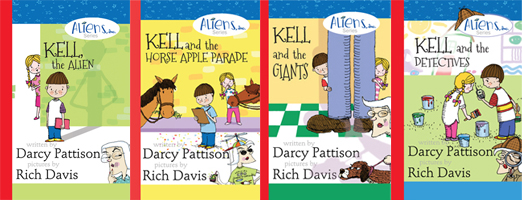
I’ve been fiddling with the opening of the second book of a trilogy, Blue Planets, for several weeks, trying to plot, trying to think of new and exciting ways to tell the story. I KNOW the story. It’s bringing it down to specifics that’s hard.
Part of my problem is that Book 1 in this trilogy opens with a scene that echoes the movie “Jaws.” That book and movie has a powerful, action packed opening image and scene that sets up the stakes clearly. My Book 1 opening echoes the action, and twists the meaning into a new, surprising direction. I like the opening I create there.
But it also set up a problem: How can I echo the “Jaws” opening for Book 2?
I’ve struggled for a couple weeks with this question and finally found the answer.
Don’t. Find another image that works.
Using a Mentor Text or Story
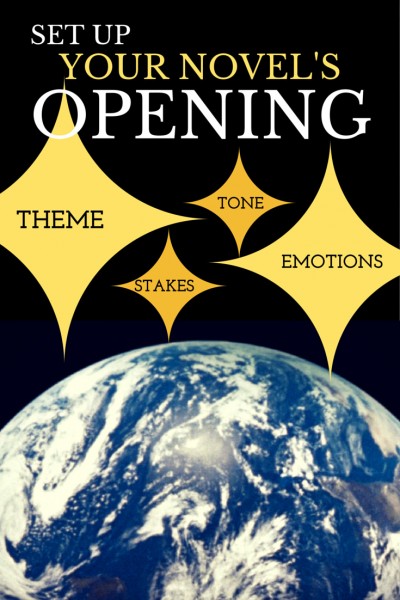
Perhaps, though, the process I used in the opening for Book 1 can be repeated for Book 2. I used “Jaws” as a mentor text, echoing its action and setting the stakes very high. What if I found a different mentor text/movie for the next book?
At Blake Snyder’s Save the Cat site, they’ve done a series of analyses of movie plots that are called Beat Sheets under his system. I decided to go through them and write a short summary of how I could or couldn’t echo the different movies for this opening. I knew that I had to approach it as a writing exercise and just go overboard and let the ideas flow.
In an hour, I wrote the summaries for the following twenty possible opening scenes. After, I went back and wrote a sentence of how the closing scene might echo back to the opening scene. That closing scene ideas — only written after all the opening scene summaries were completed — helped me evaluate how well this opening fit my story. Note also that I drew a blank on about three of the movie openings and couldn’t figure out how it would fit my story.
The Grunt Work: Writing 20 Possible Summaries of Opening Scene
Note: You won’t understand what some of this means, since I’m not explaining all the background, setting, characters, etc. That’s OK. The point is to see how I echoed the mentor text/story in some way. The link for each movie title goes to the Save the Cat plot analysis for that movie, where you can read the opening image synopsis and compare it to mine. You may think some of my opening as strangely at odds with the mentor text. That’s fine. I consider the mentor text/story as merely a starting point and go where the story takes me.
- A la Ultron.
The opening image is of a huge conch shell that is blown and echoes throughout the ocean. Jake is swimming and hears it—has to stop up his ears it’s so loud. But no human hears it—at a weird frequency. It’s an emergency call to the Mer, but Jake doesn’t know that yet. The umjaadi plague is spreading and they still don’t know what it is.
Final Echo: A hospital ward full of sick patients and the doctor telling someone that unless someone finds a cure, they’ll all die. The Mer will be gone.
- A la The Conversation .
The opening image is Edinburgh, Scotland the castle with a full moon overhead. Home of Harry Potter, the setting is almost mythical. But the reality of walking the seven hills, and climbing up the highest pulls Jake back to Earth (so to speak). From the top, he sees the Frith of Forth and the bridge—with the aquarium under it, where they’ll go tomorrow.
Final echo: back on the hill, Jake now understands what is beneath the waters he sees.
- A la Whiplash.
Jake is swimming laps in a pool—with no one around—when Cy Blevins walks in. You’re not related to the Commander, you’re the Ambassador’s son—we know all about you. OK. So, what? You can’t live here.
Jake swims, but wants to jump out and beat up Cy.
Final echo: No. Doesn’t work.
- A la Birdman.
Jake is swimming and keeps asking himself, “How did we wind up here? Am I Earthling or Risonian?” He turns sharks into tour guides, he is thrilled with electric shock from eels, he talks to octopuses.
Final echo: I am Earthling.
A la Tommy Boy.
Jake is a toddler swimming on Rison and when a camouflaged creature (octopus-like) unfurls, he is startled and starts to cry. Turns to Swann for comfort, but Swann turns him around and says, SEE. Watch. Learn to see.
Final echo: Swimming and points out a camouflaged creature to Swann.
A la Ratatouille.
B/w documentary about octopuses, compared with what we know today. They were once feared as monsters, but we now know they are very intelligent (playing with toys to get crabs). We see what we expect to see, and that changes slowly. (Or: what’s alien comes from what’s in OUR heads, not what we see in front of us.)
Final echo: B/W Risonain documentary on first contact Earth—from the Risonian POV. We now know Earthlings are much more complicated and intelligent than we thought at first.
A la Babadook.
Go for a memory and emotion. Jake relives a moment with Em where they kiss—or almost kiss. But then shakes himself. No. She didn’t want to be friends.
Final echo: A final kiss.
A la Star Trek (2009).
The camera moves along an underwater ship and reveals it to be a U-Boat. Follow with the scene of the DCS dive.
Final echo: Maybe Mom is sick from something on Earth?
A la American Sniper.
(Scene with dramatic first kill – will he shoot a kid?)
Scene with dramatic first ______?
Clearly, this one didn’t work.
A a Lego Movie.
From a boat, Dr. Max Bari lowers a figure on a stretcher into the ocean, then dives in after her—without scuba gear. He tugs the stretcher deeper and deeper until there are lights in the distance. . .
Final echo: Jake lifts off in a rocket ship and watches Earth get smaller and smaller in the distance, and turns his face toward Rison and hopes. . .
A la Big Hero 6.
Setting: Sanfransokyo
My Setting: Aberforth Hills
Final echo: Earth leaders touring Aberforth Hills
A la Liar Liar.
In a classroom, they are going around telling what their fathers do. A young Jake says his father is a test tube. No, it’s the Leader of our People. No, it’s really a test tube.
Final echo: Jake with Dad.
A la Fury.
(Ambush of triumphant soldier by vanquished.) No ideas. Didn’t work for me.
A la Gone Girl.
(Sharp contrast of emotions: head on shoulder of husband contrasted with his thoughts of killing her. Result: Worry for her safety)
Contrasting emotions? Invade Earth and just take it! Take the long, slow route to a long-term healthy relationship.
Mom is giving a speech to the world leaders about Rison’s needs. Jake is drawing pictures of skulls and wishing he could blast all of Earth so Risonians could take over. How can they ever live together on the same planet and not kill each other?
Final echo: Fight that ends in a truce.
A la Guardians of the Galaxy.
Sitting alone, Jake is listening to a cd mix that Em gave him and wishing they hadn’t quarreled. He gets a call from Marisa, who says she wants to meet with him. I hear you’re going to Edinburgh. Mom and Dad aren’t saying much—but I think Em has been kidnapped and they know who did it, but they won’t go after her. I think she’s somewhere near Edinburgh.
Final echo: Jake gives Em a cd of Risonian operas and says, I’ll be back with the cure.
A la How to Train Your Dragon 2.
Jake is spinning a globe of the world and narrating for his class (OR Swann) back home-videoconference call. He tells of how Earthlings/US once put it’s citizens in jail because they “might” have been traitors. How they questioned the loyalty of citizen merely because of their heritage. How unfair it is and how he’s worried that the Risonians will be even more feared and how suspicion will abound.
Final echo: Suspicious news reports: There are fears that Jake Quad-di is returning home with intelligence that will allow the Risonians to attack. His mother, Ambassador Dayexi Quad-di assures us that he only returns to bring back a cure for the Phoke. But why would he risk his life for them?
A la Twilight Zone.
The camera pans across oceans, racing across the seas, until it zooms in on a conference room where Mom is talking to world leaders, a clear image of politics/diplomacy.
Final echo: Not emotional enough to pursue.
A la Muppets Most Wanted.
Start with pan down from The End—the last movie—and sing about how the studio ordered a sequel.
Final echo: No. Don’t like this metadata stuff.
A la Her.
Jake is writing a letter to the editor, or editorial or something—and we pull back to see that he’s writing it for Mom. He’s her assistant now, and she trusts his knowledge of English and culture. (Not emotional enough. HER is a love story, so the emotions there are about truly falling in love. It’s not going to work in this story.)
A la Inside Llewyn Davis.
The scene opens on a rowdy swimming pool with kids taking bets. Jake lines up with another guy and when the whistle blows, the other boy dives in and races away. When that guy touches the opposite wall, Jake dives in, velcroes his legs and swims. He almost beats the other guy back, but is won out by a touch.
I win! Says the other swimmer.
Jake shakes his head. He swam almost twice as fast—and the Earthling says he won? That’s crazy.
We’re never letting you compete in the Olympics! Says one kid.
Final echo: Argument: You think I can do miracles. Sure, I can outswim any human boy, but on Rison, I’m nothing. I’m just a normal kid. How can I find the cure to the umjaadi in time? I can’t. But I have to try.
Notice that I didn’t hold myself to an impossible standard. If the movie’s opening didn’t spark something almost immediately, I moved on. Further, I didn’t stop at just one try. I persevered, knowing that I needed to fully explore my options.
Evaluate the Possible Openings
After writing all of these, I had to evaluate which one fit my story best. First, I went back and added the Final Echo to each, so I’d know if it fit the theme/plot/characters well enough to carry through the whole story. In other words, I double checked my ideas about the story, my intentions.
Then I asked these questions of each opening:
- Which sets the tone I want?
- Which sets the emotional problems?
- Which sets the themes?
- Which one sets up the stakes as very high?
Results of Opening Images Writing Exercise
I found several good images that took me in new and different directions than I’d previously been trying—and that’s exciting.
- Warning conch shell – warning comes true, all Mer sick.
- Jake as toddler scared by octopus-like creature un-camouflaging – Watches old Risonian documentary and realizes that Earthlings are complicated.
- Dr. Max lowers a patient into the water and goes into a foreign world – Jake lifts off in rocket for a foreign world.
- Listens to Em’s cd – gives her a cd when he leaves.
- Jake narrates the globe – a news show narrates Jake’s trip to Rison.
- Jake outswims Earthlings – but realizes he’s just a normal kid on Rison.
Which one did I choose? Actually, several. Because I have a main plot and several subplots, I realized that several of these can work in sequence to open the different subplots.
Sometimes, I approach a story methodically, just doing a writing exercise. This time, I was stuck, and the exercise unstuck me. That was a valuable hour of writing!


By: Martha Alderson, M.A.,
on 10/22/2014
Blog:
Plot Whisperer for Writers and Readers
(
Login to Add to MyJacketFlap)
JacketFlap tags:
Memoir,
revision,
NaNoWriMo,
rewriting,
nano,
first draft,
screenplay,
revising a novel,
fast writing,
writing in drafts,
Add a tag
Every writer I know, it seems, is either preparing now to write a fast draft during NaNoWriMo, has a jump-start on November by speed-writing now to finish by the end of the year or has given up.
With novels anywhere from 50,000 (slight) to over 100,000 words, writing a fast draft gets you to the end faster. Problem at that point is knowing you're not finished -- not by a long-shot.
One of the biggest shocks for novelists just starting out is the realization they may have to write more than one draft -- several even. You get the end of draft 1 euphoric, only to understand how much work is still left to be done. You want it to be over. You want your story perfect in the next rewrite. You even work through all 30 exercises and 5.5 hours of video instruction during
PlotWriMo, revision your entire story, only to rewrite again. And perhaps again and again.
Begin now by accepting that the fast draft you write now, you may have to rewrite all those thousands of words again later. Then put your head down and get to writing. Finish by the end of the year.
Writing a fast draft demands consistent and powerful writing.
Consistent writing is a tough one to achieve for writers who insist they can only write when they’re inspired to write. Consistent writing means showing up to write whether you're inspired or dull, frightened or brave, energetic or lazy. You show up and write anyway.
A consistent writing regime is helpful, especially so writing a fast draft. A tight deadline of a month facilitates fast writing -- no time for procrastination, no time to wait for inspiration. Every spare moment must be devoted to writing or pre-plotting to succeed at completing a fast draft in a month.
Today I write! Rather, today I pre-plot for NaNo!
30 Days to a Stronger Novel Online Video Course
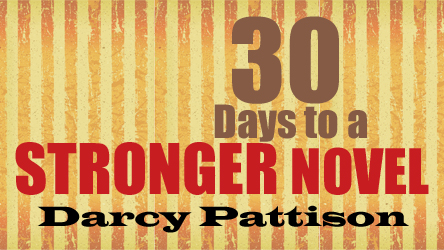
I confess: I love a good cliche or trope.
A cliche is a phrase or expression that has been used so often that it is no longer original or interesting.
A trope is a common or overused theme or device, as in the usual horror movie tropes.
I’m in the middle of plotting a massive 3-book story and I need all the help I can get. Here’s the problem: what happens next?
No, let me rephrase: what could possibly happen next?
Sometimes, I just need to know possibilities, or what a story typically does at a particular stage. What are the possibilities? Is this a place for a murder, a confession, a love scene, or a time to gather information?
Literary folk say that there are only a limited number of stories in the world. Depending on who you talk with, there might be just two stories: a character leaves town, or a stranger comes to town. Others say there are up to 32 plots. I’ve written about 29 plot templates before. And it helps immensely to narrow down the choices.
But that’s on the level of an outline. Now that I’m deep into deciding on scenes, my imagination comes up short.
Enter tropes. A trope is a common theme, something that’s been done before. That doesn’t scare me away, because it’s the same as the variety of themes. Every story is a cliche, trope or template in many ways. It’s all in how you TELL that story. The beauty is in the particulars.
Romantic Subplot
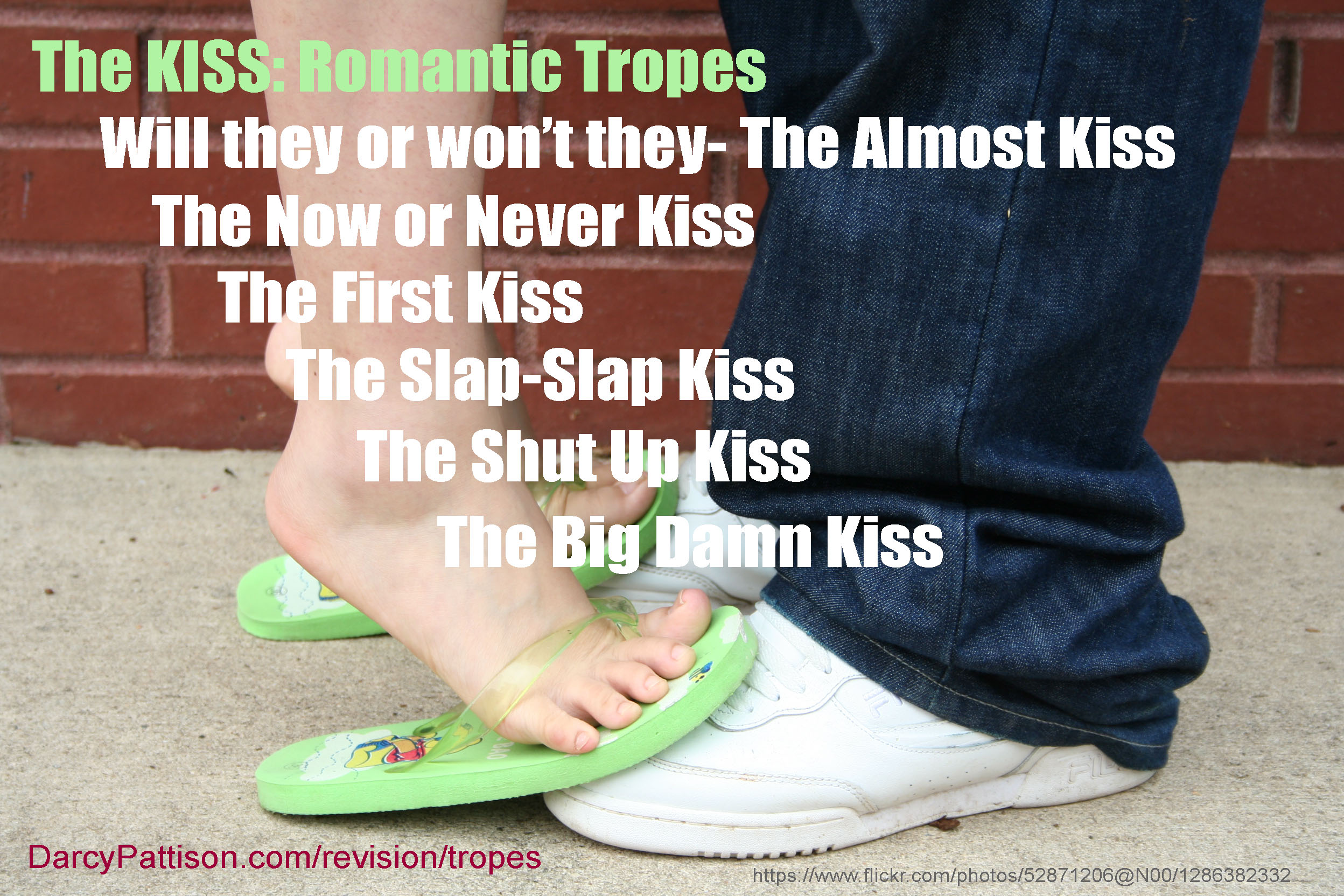
My story needs a romantic subplot. I know the basics.
Act 1: Boy Meets Girl/Girl Meets Boy
Act 2: Boy and Girl Fight or are otherwise kept apart.
Act 3: Boy and Girl get together.
But what else? What is possible at each stage?
I turned to TVTROPES.org for help. Their site is a wiki that list all sorts of tropes. The Romantic Arc Tropes list was helpful because it listed typical things that happen at every stage of a romantic relationship.
For example, a story might start with this trope/subtropes:
Love Before First Sight
- Because Destiny Says So
- Childhood Marriage Promise
- Red String of Fate
- Girl of My Dreams
- New Old Flame
Each of the tropes listed has its own wiki page, which explains the trope in detail. Particularly valuable are the examples drawn from traditional literature, manga, comic books, fanfics, films, live-action TV, professional wrestling, table top games, theater, video games, webcomics, western animation, real life and more. It’s a treasure trove of examples of the POSSIBILITIES of a particular stage of a relationship.
In fact, I used this romance arc by choosing one trope from each stage of a relationship and slotting that into my story.
Place Holders
Are you afraid that my story will be trite and boring? I’m not. I know that this is a trope and therefore, I must transform it in the storytelling phase of the project. Right now, though, this trope acts as a place holder, something that indicates approximately what will happen in this spot of the story, but not exactly. The nuances that make it fresh await the actual writing.
Using tropes to hold a place with something reasonable makes the plotting easier. I’m loving this help in plotting.
Here are some Arcs to get you started. Be warned: this is a massive wiki and it’s easy to get lost in it. Know what you are looking for and get it/get out.

.jpeg?picon=2450)
By:
Sherrie Petersen,
on 9/15/2014
Blog:
Write About Now
(
Login to Add to MyJacketFlap)
JacketFlap tags:
editing,
writing,
novel writing,
outlines,
outlining,
rewriting,
writing inspiration,
first draft,
writing journey,
Wish You Weren't,
Add a tag
Many years ago I attended a writing conference and one of the authors recommended writing your entire story, then throwing it away and writing it again. The rationale was that writing the first time was to help you get to know the characters. Writing the second time was to finesse it and tease out your […]
Some fear the blank page. I fear the half-written page.
I was writing along, doing great on a story when life interrupted (how dare it!). Has that happened to you? You know where the story is going, you’re in the drafting mode and going strong and BANG! Something happens. You have to set the story aside for a while.
Momentum is lost.
The story almost seems lost, too.
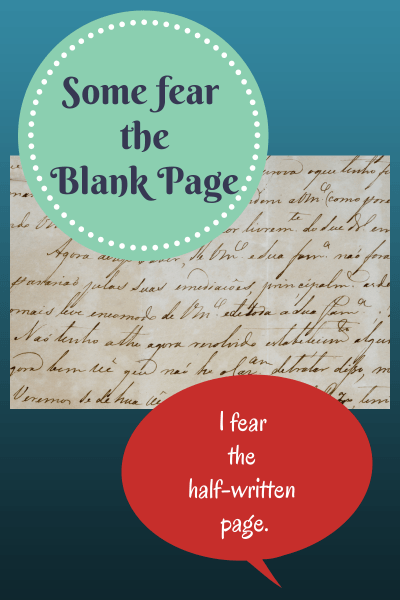
When life interrupts your story, how do you get back into it?
Picking up the Threads of an Abandoned Story
The first thing I’ll do this week is re-read the story. It’s important to see what I actually put on the page.
Next, I’ll try to recapture the excitement and recreate my mindset. This means looking at notes, images, reference material or anything else that will help remind me of my place in the story. Maybe I’ll need to write a letter to myself about how excited I was when I was writing the story.
Retype a chapter. If that doesn’t help, I’ll retype a chapter and make small edits as I go.
Move the pen across the page. When I taught freshman composition, I used a technique that always worked. I insisted that the student move the pen across the page and write words. In other words, they had to go through the motions of writing.
“What do I write?” they moaned.
“Doesn’t matter.”
“I don’t know what to write.”
OK. Write this sentence and keep writing it until you want to write something else:
I don’t know what to write, so I am writing this dumb sentence.
Inevitably, after writing that sentence once or twice, the student segued into something else.
If all else fails to get me back into the story. I’ll do the same thing. I’ll sit and go through the motions of writing until I get so bored with the drivel that I’ll start to get creative and something will happen. I only hope what happens on the page is magic!


.
How do you take an idea to a book? I am just starting the process again and every time, it overwhelms me. I know the process works, but it seems so daunting at this first stage. So, I only look forward to the next task, knowing that taking the first step will lead me onward.
For this story, I’ll approach it on several levels at once:
Outlining. This is the fourth book in an easy-reader series, so I know the general pattern that the book will follow over its ten chapters. Chapter one will introduce the story problem and chapter ten will wrap it up. That leaves eight chapters and each has a specific function in this short format. Chapter 2 introduces the subplot, chapter 4 intensifies it and chapter 6 resolves it. That leaves chapters 1, 3, 5, 7-10 for the wrap-up. Chapters 9 and 10 are the climax scene, split into two, with a cliff hanger at the end of chapter 9. In other words, I can slot actions into the functions of each chapter and make it work. Knowing each chapter’s function makes it easier–but not automatic. I’ll still need to shift things around and make allowances for this individual story.
Character Problem. Making my characters hurt is the second challenge. Squeezing them, making them uncomfortable, making them cry, dishing out grief and mayhem–it’s all part of the author’s job. I tend to be a peace-maker and find this to be quite difficult. But if I can manage to bring my character’s emotions to a breaking point by chapter 8, I’ll be able to move the reader. I’ll be searching for the pressure points for the character as the outline progresses. Hopefully, the emotional resolution in chapter 9-10 will be a twist, something unexpected by the reader.
Back and Forth Between Outline and Characters. The nice thing about focusing on just this much at first is that it is interactive. I’ll go back and forth between plot, character and the structure demanded by this series until the story starts to gel. Will it be easy and automatic? Oh, no. I’ll be pulling out my hair (metaphorically) for a couple days. But by the end of the week (I hope) there will be progress.
How do you start your story? Do you free-write, create a character background, or outline? Which parts interact as you create the basis for a new story?
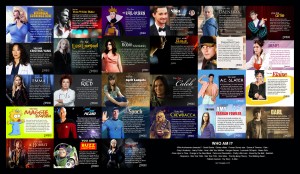
What Character Are You? Click to Enlarge. Photo Credit: http://www.flickr.com/photos/bk/12392396893/

ONLY 3 DAYS LEFT
I am in the midst of a truly awful first draft. Really. I have NEVER written such a bad first draft.
This is a sequel and it must be written to roughly follow an outline, but the outline seems sorta dead.
Here’s what I am doing:
 Push on. I am pushing forward, trying to write something, anything. Sometimes, the story is flat and sometimes it sings. Doesn’t matter. My goal this week is to finish a draft.
Push on. I am pushing forward, trying to write something, anything. Sometimes, the story is flat and sometimes it sings. Doesn’t matter. My goal this week is to finish a draft.
Trust the process. I am trusting the process. I know that the story won’t end with this draft; there will be multiple drafts after this, plenty of time to fix the glaring problems of this draft. It’s the only reason I am allowing myself to forge ahead, because I know that this is a process, not a static thing that I work on once and never again.
Update: As I pushed forward this week, the story did indeed start to connect as a whole. There are still many elements that are unconnected, but I am confident that I can get there. I keep thinking about Linda Sue Parks comments about her Newbery title, A SINGLE SHARD (Clarion, 2001). She says that she tried to make sure each chapter has something that looks forward and something that looks backward. For example, if she has a character use a gourd to get a drink from a spring in one chapter, she makes it her rule to use that gourd again somewhere else. The story starts with a basket-backpack leaking rice; partly, it starts there because the main character uses a basket-backpack to carry his master’s pottery to the capitol. If the backpack was necessary to the story, according to her rules, she had to use it somewhere else. THAT is what is missing in my story right now. There are elements that I threw into the first draft–because that’s what first drafts are for–but I’m not sure yet, if they will weave into the fabric of the story. For example, the main character notices in chapter one that someone has a nickname and realizes that he doesn’t have one. Right now, the story doesn’t resolve that. I need to either remove the reference entirely–or the story has to deliver him with a really great, appropriate nickname.
Experiment. Everything is going so badly anyway, that I feel free to experiment. I am throwing in snatches of conversation, snippets of a scene, trying out wording for actions–in other words, experiment. I would say that I am playing, but this time, there is just the hint of despair in the writing, since it is going so very badly. I am really searching for a voice that works. Maybe it needs another narrator? Maybe it needs a different setting? Anyway, I am allowing tangents that I would normally cut off.
Role of First Drafts. Most of all, I remember: the purpose of the first draft is to figure out what story you are telling. The purpose of all other drafts is to figure out the most dramatic way to tell that story. I remember that I am figuring out what story I am telling. So–I allow myself to, well, to figure it out. Slowly, painfully–the story is starting to shine through. It will be there within this draft, waiting for me to recognize it and polish it. I am just trusting the process and writing a really lousy first draft.

My current WIP novel has a subplot of a chase, which is one of the 29 possible plot templates. Chase Plots are pretty straight forward. There’s a person chasing and a person being chased, the Chaser and the Victim. It’s an action plot, not a character plot (though always, character should be as strong as possible.)
The Chase plot has one major imperative: The Chaser must constantly catch sight of the Victim and the Victim always escapes by the narrowest margin. Otherwise, it’s boring. This subplot must tantalize the reader with the possibility of Chaser actually catching Victim.
My first draft of chapter one completely omitted the Chase subplot, so the first revision I did was to revisit the idea of a Chase Subplot. Yes, the story still needs it. Then, I had to decide how to add in the Chase subplot in an exciting way. What could I add that would give the Chaser a glimpse of her target? My twist on the Chase Plot is the Chaser doesn’t always recognize the Victim. So, I gave Chaser a smart phone app that identifies the Victim. Now, Chaser walks up to a table where Victim is sitting and the app starts to go off, but. . .Chaser is interrupted.

The Car Chase is a staple of Chase Plots. You can choose any form of chase, though, and still up the tension of your story.
Victim is almost caught and only escapes by chance. Because the story is in Victim’s point of view, this works because Victim realizes the danger he was in. Chaser is still clueless, of course, but that’s OK, because it’s not her POV.
Having a chance escape also works this initial time, because the scene introduces the rules of the Chase scene. But now, Victim KNOWS there’s a smart phone app and will have to use his ingenuity to stay out of range of that app. It will, of course, be easier said than done.
The whole scene has upped the stakes in the story as a whole. The other subplots are now free to carry on as needed, because at the right moments the Chase Subplot will be there to add to the story’s tension. Will Chaser actually CATCH Victim? Who know? Stay tuned!
What subplot(s) are you adding to you story to keep the tension high?

I am working on a first draft of a story and am reminded of a couple things.
First, you must write the story. You can plan all you want, but the story comes alive in the actual writing. A small thing this week: my main character is afraid of all bugs. That includes insects and anthropods (spiders)–anything that crawls or flies. So, there they are, the Main Character(MC) and Best Friend (BF) sitting in art class and painting. Guess what the BF paints? An anteater! It’s a perfect addition to the story but I hadn’t planned on it. It came about simply because I wrote the first draft of the first chapter. And there it was.
We don’t know what we think until we write.
We don’t know what the story is until we write.
It’s like sports. You can predict who will win or lose a game, but the teams must still play the game. And there are always surprises.
Write your story. It will surprise you.

The second thing that is happening is not as nice. The story is boring.
I am still feeling my way through the story to find the line of tension, the exciting bits. I’ll keep writing even if it’s boring, because I am digging up anteaters. To use another bug metaphor, I’ve spun a web and I am sitting like a spider monitoring the web for the slightest hint of movement. When the movement–or story excitement–happens, I’ll be ready to pounce. It’s called trusting the process. It’s the most exciting and satisfying thing about writing, when a story comes together on many levels. It’s also scary: I KNOW this is a boring chapter, too full of static action and talking heads. I KNOW it’s bad. I could throw up my hands and just quit. Instead, I’ll plod along and write through the problems until I find something exciting. I can delete this boring chapter later (and, I will!). For now, I am trusting the writing process to get me to a stronger story. And it will.



Today, there are no words on the page that I can point to and say, “I wrote that today.”
But it was still a successful writing day.
I reread the first book of a series and got the voice and characters back in my head. In the early stages of prewriting, I need to see what went before and how I can play a variation on the them for this new book.
I worked on new characters and situations for the second book. And it will take me a couple more planning days, as I try something, reject it, and try something new. The firs things that come to mind are likely the weakest and I need to push past those cliches to something more fun. Unfortuntately, that means there has to be something there to push past. Which means grunt work of writing bad ideas to reject, so the good ideas can come forward.
I set up a folder for Book 2 and added two documents to it. Getting organized mentally, getting files organized, setting up work folders–all of that prepares me mentally to work. I am setting myself up for success. I will have all the tools and processes in place.
I decided to start on this next Tuesday, September 3. By setting up a “trigger,” or a deadline, it gives me a mental head start on what I need to get done before then and encourages/forces me to make decisions this week that will create a successful start to a new project.
I also set a deadline for finishing the first draft of the project. By adding the end-date to the project, it also sets me up to be professional in the writing, to set a goal of writing a certain amount per week. 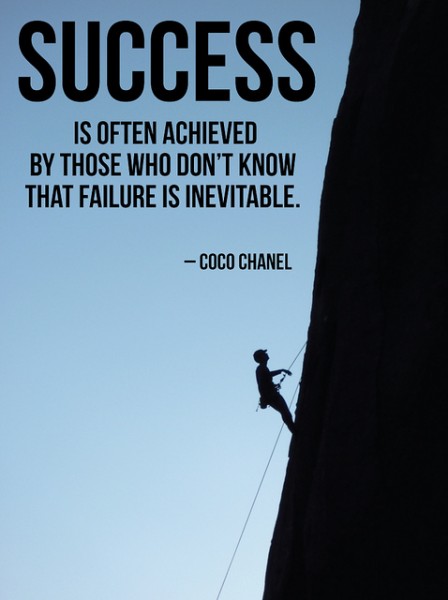
In everything I do this week, I plan to set myself up for success. What are you doing to set yourself up for success?

The best piece of writing advice I ever got came from Bird by Bird by Anne Lamott. It had to do with accepting the idea of “shitty first drafts.” The second best piece of advice came from a professor whose teaching assistant I had been in English graduate school in the 1960s. He had struck me, when we first met, as incredibly brash, an effect that he was deliberately seeking to achieve. He’d barge into the classroom, send the blinds crashing up or down, and lie on the desk with a cigar between his teeth. “I’m Smith,” he’d say to a wide-eyed class. He went on to become a rock star of literary criticism, publishing countless books, writing regularly for the New York Times, becoming an internationally famous intellectual. He even appeared as a character in a well known novel.
His advice? “Always recycle.”
“First,” he said, “I write a talk. Then I give it in several times. I turn the talk into an essay and publish it. Maybe it becomes part of an anthology edited by someone else. Then I use it as a chapter of a book or include it in a collection of my essays.” I remember him chewing on a cigar when he told me this. But I may be making up the cigar.
I feel comfortable with Lamott’s advice. I am perfectly capable of producing “a shitty first draft” and of feeling, as she does, that I’d just as soon not die while it is lying on my desk, lest someone read it and assume my death was suicide. But following the guidance of my brash professor was another matter. Who me? I thought. I’m allergic to cigars. But, in the end, I tried his system. As an academic I wrote talks, wrote them into essays that I published, saw them anthologized, and gathered them into a book. I did not become an academic rock star or take up smoking, but the method served me well. I published, and at each stage became a better writer.
When I retired and began taking classes in creative writing, I fell into the system out of habit. I wrote pieces for my writing classes. I turned the pieces into blogs. I posted them on a collective site. Then I posted them on my own. Eventually, I did guest posts with the same materials. After four years, several posts have been anthologized and most of them are chapters in my memoir. Others are beginning to look a lot like a collection of essays on food and place. Good job, I told myself, thinking this would be the end, but then I hired a publicist who told me “No.” Now I had to link my book to larger issues. So, in preparation for the memoir’s launch, I began to write some essays that made those links. One is to be published but, even better, I have begun to see more clearly what the book is all about, and I have a new set of ideas to explore. So recycling? I’m a fan and I’m passing on my famous professor’s advice to you. Because once you’re past the stage of “shitty first draft,” it’s not just about recycling. It’s about revisioning and writing better as well.
* * *

~~~~~~~~~~~~~~~~~~~~~~~~~~~~~~~~~~~~~~~~~~~~
Would you like to participate in Friday "Speak Out!"? Email your short posts (under 500 words) about women and writing to: marcia[at]wow-womenonwriting[dot]com for consideration. We look forward to hearing from you!~~~~~~~~~~~~~~~~~~~~~~~~~~~~~~~~~~~~~~~~~~~~
Follow our Pinterest Boards
When you write a first draft of a novel, you may be prone to spaghetti problems. The term was coined by Jon Franklin in his book, Writing for Story, which is about writing nonficiton; but it’s a useful concept for any type of writing.
Spaghetting is when you are writing along without a clear idea of where your story should go and you wake up one morning and the story is so tangled it seems like a plate of spaghetti. This happens to organic writers (otherwise known as those who write by the seat of their pants, or pansters), but also to those who are semi-organic-semi-planners (sometimes known as plansters). Strict outliners might avoid this problem, but they will have problems of their own.

I am a Semi-planner: I know the overall thrust of the story, the character’s main emotional arc and where the story will end. With that in hand, I semi-plan the opening act, then start writing. I know that somewhere in there, I will have to stop and re-plan the next section of the story. That’s because the story tends to spaghetti.
Spaghetting can happen when you decide to take off on a tangent, just to see where the story might go. And it might go straight into spaghetti; or it might take off into space, with celestial angels channeling through you. Mostly, mine spaghettis.
When this happens, don’t panic. (Oh, it’s at THAT stage.) Instead, you must put on your left-brained analytic hat and look at what you’ve done. Where did the story start to get off track?
Try to pinpoint the exact place where something started going wrong. Put your cursor at that spot and highlight everything after it. Cut and paste that spaghetti section into a new file and call it Spaghetti-1. I hate to delete anything totally! There may be a couple things in that file that I need.
And then, analyze where you are in the story. What has happened up till now? Where is the character on his/her emotional arc? List possible scenes for what might happen next and work on plotting from this point onward. You may need to go back and clean up traces of spaghetti sauce in previous chapters, but you can probably go forward and wait till the full draft is done.
This is a much better strategy than abandoning a mss after 100 pages–something I’ve been known to do. Instead, get rid of spaghetti pages, replot and get that first draft done.

To understand novel revision, there are three basic concepts you must grasp.
First, is the idea that when you finish a novel, there are now two novels. There’s the one on paper and the one in your head–and they are not the same. One of the major tasks of revising your novel is to make sure everything in your head is on the paper. How many times do readers say to you things like this: I don’t understand. I can’t visualize how that happened. I am confused.
And you are totally surprised, because of course, it’s right there in the story. No. You didn’t put it on the page.
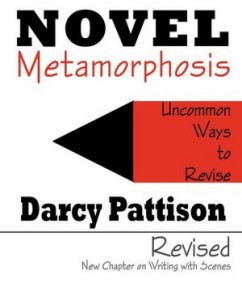
Second, you are also trying to match up your story to your concept of an ideal story. An ideal story–according to you–might be one with lots of action, stirring emotions and a great love story that resolves at the end. Or it might be one of slowly peeling back the layers of action to reveal a character. Whatever your ideal story is–you didn’t hit it on the first draft and the second draft is your chance to try it again.
Third, and related to the first two, the function of a revision is different from the first draft. In the first draft, you are figuring out what story you want to tell. In the second and subsequent drafts, you are figuring out what is the most dramatic way to tell that story. What can you change, how can you structure it differently, so that your reader stays engaged the whole way through?
Revision is the only way to achieve a publishable novel and it’s not scary. It’s just a different phase of writing the story from the first draft–making sure what’s in your head is on the page, and one of matching up a story to an ideal story, and one of considering your reader and making sure you keep that reader the whole way through.

 Do you dream about writing a novel one day? Every aspiring writer has to start somewhere. Before you start writing your novel’s first draft, it’s wise to do your research and learn as much as you can. Watch the preview video below from the Writer’s Digest Tutorial titled 8 Things First-Time Novelists Need to Avoid and find out what the most common mistakes are that beginning novelists make. Knowing how to avoid these errors when writing your own novel can save you from frustration in the future.
Do you dream about writing a novel one day? Every aspiring writer has to start somewhere. Before you start writing your novel’s first draft, it’s wise to do your research and learn as much as you can. Watch the preview video below from the Writer’s Digest Tutorial titled 8 Things First-Time Novelists Need to Avoid and find out what the most common mistakes are that beginning novelists make. Knowing how to avoid these errors when writing your own novel can save you from frustration in the future.
Eight Mistakes to Avoid When Writing a Novel
Writing a novel is not easy but the journey is often worth it when you have a complete first draft in hand and the opportunity to get published. Publisher and story editor Charlotte Robin Cook and Jon James Miller, an award-winning screenwriter and debut novelist, share the eight mistakes first-time novelists make in the video below. To hear more details and information, purchase the entire tutorial video and discover how to impress agents and editors with your writing.
Did you enjoy this tutorial preview? Buy a 1-month, 6-month, or 12-month subscription and watch unlimited tutorials on writing and publishing!
 If you are writing a novel for the first time, you’ll need to know when and how to end a chapter. Learn about chapter breaks and see examples of some from popular novels in the following excerpt from the book Your First Novel by Ann Rittenberg and Laura Whitcomb.
If you are writing a novel for the first time, you’ll need to know when and how to end a chapter. Learn about chapter breaks and see examples of some from popular novels in the following excerpt from the book Your First Novel by Ann Rittenberg and Laura Whitcomb.
Novels have all different styles of chapter breaks. Some have dozens of short chapters, some have a few huge chapters (often called parts or books), and some have no chapters at all. The chapter break should be placed strategically. If, while constructing your outline, the thought of separating your plot into chapters confuses you or saps your energy, don’t make chapter break decisions yet. Write a first draft of the whole novel, then come back to this section to place your chapter breaks with intention during your rewrite. But if, as you think about your story, the discussion of chapter breaks stimulates your imagination, construct your outline with chapter breaks included.
Take a look at your favorite novels. How did the author break up the story? The most important thing is that at the end of each chapter the reader should be craving the next chapter. Make the reader want to turn the next page. An old-fashioned cliffhanger is not required (though they still work), but tension of some kind is essential. End not where the action lulls but where it is the most dynamic. Give the reader new information right before you cut him off. The following are examples of strategic chapter breaks.
BRIDGET JONES’S DIARY, BY HELEN FIELDING
14 CHAPTERS, 271 PAGES
At the end of chapter “April” Bridget hints that she might be pregnant and then titles the next chapter “Mother-to-Be”—again, we have no self-control. We must read on. It’s especially easy to keep reading Fielding’s novel because the diary entries are often short. Just one more, we tell ourselves. It’s addictive.
LULLABY, BY CHUCK PALAHNIUK
44 CHAPTERS, 260 PAGES
Chapter six: The hero tries a killer poem out on his unsuspecting boss. If it works, the man will be dead before daybreak. Instead of ending the chapter with news of the death, Palahniuk stops right after the hero decides not to try to explain the experiment to his employer.
“We both need some rest, Duncan,” I say, “Maybe we can talk about it in the morning.”
Of course we can’t wait—we have to start chapter seven.
THE PRINCESS BRIDE, BY WILLIAM GOLDMAN
8 CHAPTERS, 399 PAGES
Chapter five: We know one of the characters has spent his whole life trying to track down an anonymous nobleman with six fingers on his right hand. At the end of chapter five another character notices that the man who is about to torture him to death has an extra finger on one hand! It doesn’t matter that chapter five was one hundred pages long, or that chapter six is fifty-nine pages long; we have to turn the page.
Buy Your First Novel now!
 No matter what type of novel you want to write–horror, romance, science fiction, mystery, or fantasy–we have bundled some of the best books, webinars, and workshops together to help you write a novel. When you buy this month’s premium collection, 10 Essentials for Writing a Kick-Ass Novel, you will learn how to structure your novel and tell your story effectively, get the essential tools you need to start and finish a novel, and learn what editors and agents look for.
No matter what type of novel you want to write–horror, romance, science fiction, mystery, or fantasy–we have bundled some of the best books, webinars, and workshops together to help you write a novel. When you buy this month’s premium collection, 10 Essentials for Writing a Kick-Ass Novel, you will learn how to structure your novel and tell your story effectively, get the essential tools you need to start and finish a novel, and learn what editors and agents look for.
Learn How to Write A Fiction Novel With These Resources On Novel Writing
If your goal is to write a novel in a month, finish a novel, or simply learn how to write one, you’ll find the best advice and tips on novel writing in this premium collection which includes:
- The Writer’s Compass: You’ll learn how to organize your story’s ideas and events through story mapping and the seven stages of writing. You’ll also receive tips on writing a novel, including, building your story’s structure, creating memorable characters, and developing crucial scenes.
- The Plot Thickens: Write a novel that catches the attention of agents and editors! In this online writing webinar, author, editor, and literary agent Andrea Hurst discusses plot methods and story structure. She also explains the reasons why manuscripts are rejected and what agents look for in a story.
- From First Draft to Finished Novel: Discover what it takes to write a novel from start to finish. You’ll learn the fundamentals of writing, including the basics of developing characters and plot, strategies for self-editing, and general guidelines for submitting your novel.
- Start Your Story Right: When writing a story, it’s essential to craft a strong beginning that grabs the attention of readers and agents. Guest speaker and literary agent Sara Megibow discusses how to write strong opening scenes, examines common clichés and problems, and shares insight into what agents and editors look for.
- Novel Shortcuts: Develop your story and turn an idea into an amazing novel—fast! Whether you are pressed for time or simply want to write a novel faster, you’ll explore time-saving strategies and tools for writing your first draft. You’ll also find practical exercises and comprehensive checklists to help you tackle the writing process.
Maybe you aren’t writing because that internal editor demands perfection.
Lower your standards.
I am running again, following the Couch 2 5K program and there are days when it is hard! (Every day!) Like Monday. My legs gave out after 15-16 minutes and I stopped long before my planned 30 minutes. Still. That was more than I was running 3 months ago. I was a success. That didn’t mean I gave up on my goal of 30 mintues. I did that today, this morning. My goal this morning was 30 minutes, or at least, more than I ran on Monday. At 26 minutes into it, I wanted to stop again. But, gee, only 4 minutes left. You can’t stop then. I finished the whole 30 minutes. I did it by lowering my standards temporarily (beat Monday’s measly 16 minutes), and allowing myself to fail. On the other hand, when the finish was in sight, I made sure I didn’t stop.

So, in a first draft, we lower our standards. It’s just a first draft, get something on paper! Later, you can clean it up, revise it, or throw it away. But get the story down!
Writer’s block? Lower your standards! (Shh! Temporarily.)
For humorous cartoons on Writer’s Block, see my Pinterest Writer’s Block Humor board. IF you have great cartoons on this, please send them my way!

There are two types of first-drafters for novels: those who write too short and must expand and those who write too much and must cut. Today, we’ll talk to those who need to cut when they revise their story.
One complaint for drafts that are too long is that they have too many plots. The first draft is to help you figure out your story; the next drafts are to figure out how to tell that story in the most dramatic way. That’s good theory, but let’s make it more practical. Where do you cut? What criteria do you use?
Who hurts the most? The most dramatic stories will be the most emotional stories. One criteria for revising is to ask, “Who hurts the most?” Where in the story do you find the most emotion, where is the most at stake?
Drama means that something is at stake: the survival of the species, survival of a town or community, survival of a teen in the midst of teasing or bullying, survival of a closely held dream. As you look over your plot and subplot, one goal of revision is to cut subplots with nothing at stake, while raising the stakes in everything you have left.

Who hurts the most in your story?
For example, if a teen is worried about surviving a bout of teasing, raise the stakes by putting a love interest close by to watch. Now, the teen is risking both safety, pride and the love-of-her-life.
Does something actually happen in this subplot? Let’s say that you take out subplot A. Does the story change? Is this subplot integral to the story, so important that omitting it will change the whole tenor of the story or novel. Some subplots are just fun detours: omit them. Some subplots add flavor or setting or deepens a character; and yet, nothing really happens. If you take bits and pieces of the subplot and slot them into the remaining subplots, you won’t miss the subplot at all. Do the actions of this subplot really advance the story or not? Is this subplot crucial to the story or not? IF not, be ruthless and cut.
Add a subplot. What? I have a story that is too long, but you say to add a subplot. Not exactly. Maybe, though, you can take the extra bits and pieces and restructure them to create a subplot. Instead of disconnected bits, can you build a narrative arc–a subplot–from them? (And while you’re at it, make it all shorter!) Remember that a subplot, by definition, doesn’t have as many plot points as the main plot. So, pick and choose only the strongest scenes to create this new subplot. While you’re at it, try to interweave the subplots and plots to make a more coherent whole. Have the climax of the subplot become a plot-point in the main plot. Failure to defeat the bully means that the teen winds up in the hospital, which means she can’t attend the prom.
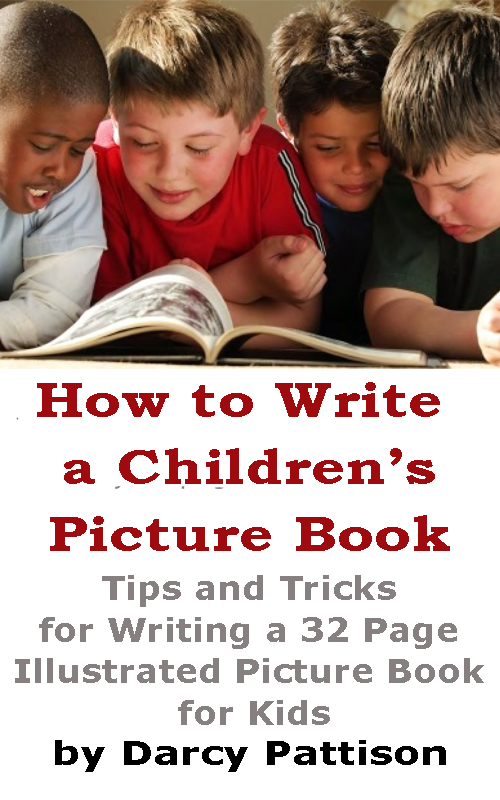 |
-
 The Great Wall was built one stone at a time; you climb it one step at a time; your story is written one word at at time. Slow and steady can create magnificence. (I am in the orange & white hat.)
I am stumped, not blocked. I know that something in my current writing project needs to change, I’m just not sure how to best accomplish it. It’s partly a matter of organization–this is a nonfiction project–making sure that everything is included, ideas flow logically. But as is so often, it’s not straightforward. I could go in a couple different directions.
I’m at the point where I probably need to commit to one structure, write a draft and get feedback. Sigh. The writing process needs that feedback loop. I will need to know how clear my ideas are and if someone can use this to accomplish something: will the information be helpful in this format?
As I write this draft then, I will keep my audience firmly in mind. Sometimes, I just write for the story or the ideas and don’t worry about the audience. But this draft is different. After a couple drafts, I know the material, so this draft is about communicating with clarity. Fiction gets to that point, too, when you know the story and the next draft is about clarity so the reader experiences the emotions of the story.
The first draft is almost always about finding the story or the idea. After that, the purposes of a draft of fiction is to find the most dramatic way to tell that story so it will impact readers emotionally. For nonfiction, the purpose of subsequent drafts is to find clarity and, if it’s creative nonfiction, to find that reader experience, too.
That’s where I am today–where are you in your writing process today?
 | |
NEW EBOOK
Available on
|
For more info, see writeapicturebook.com

I said I'd finish the last scene today and I did! Look, it's barely noon and I just wrote those magic words: The End. 100 pages. Ten short of what I thought it would take, but actually that's good. That's a good amount of pages. I can still add if I need to, or cut if I need to. Ninety minutes made a full evening and can be run without an intermission. Or if I need to add, we can have an intermission. Either way it's all good. I did this one so it can be rated PG. You could perform this one in Middle Schools. Although it's an adult drama, I'm just sayin'. It could be performed in churches. Maybe. There are a few hells and damns.
There is conflict, both inner and outer. There is soul-searching and there is character arc. There is social change going on. I'm not saying this is a perfect first draft. I'm saying this might be a good play after I get some feedback. It has potential. It has a table read coming up, and it has a staged reading scheduled for Fertile Ground in January. Now to send her out into the world so other readers can lay their eyes on her. Bye bye baby!
I woke last night and wrote and rewrote endlessly the first line of my new novel. Yes, it is an important line, but it’s not important enough to stop me from writing a first draft of the first chapter.
Place Holders
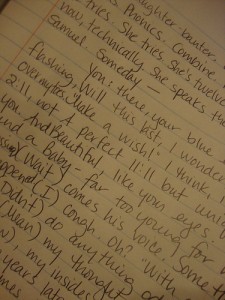 I like the idea of place holders in fiction. That is, you write something–a sentence, a title, a paragraph, a joke, a piece of dialogue–knowing that this isn’t the best it can be, but also knowing that you’ll come back and fix it. I like the idea of place holders in fiction. That is, you write something–a sentence, a title, a paragraph, a joke, a piece of dialogue–knowing that this isn’t the best it can be, but also knowing that you’ll come back and fix it.
Place holders have an important function in the first draft. They let you get the story told, without fussing over the exact details. You get a sense of momentum, that you are moving forward. The story is the focus of the first draft, getting it down on paper, from first to last, opening scene to climax to denouement.
The function of the first draft is to find your story.
The function of the next few drafts is to find the best way to tell that story.
So, using place holders in the first draft makes perfect sense.
 NonFiction BookBlast
Sunday, June 26, 2011. 8-10 am.
ALA Conference in NOLA.
NonFiction BookBlast
Sunday, June 26, 2011. 8-10 am.
ALA Conference in NOLA.


Plunging ahead into a fifth or sixth draft of a novel or the 10th revision of a short story, there have been some hurdles along the way, but for the most part, it's been smooth sailing. Right?
What if it has been rocky. Perhaps the novel revision has dropped lower and lower on the list of things to do. Finally the revision process drops out of the bottom of the list--behind cleaning the storm gutters and washing the windows. The energy once used to get through the first through nth draft isn't there.
It's become a struggle. Writer's block is not to blame.
Writing is a passion and is flowing through other writing projects. And, in the past, revision has been a relief (especially as an escape from household chores!).
When a revision is dragging, how soon before deciding that, yes, the writing is fine. The structure is passsable.
When is it time to consider that perhaps it's the initial idea that needs to be discarded or re-tooled?
Sometimes taking a look at the initial idea of a story--even after following it through several drafts--can prove to be the root of the problem. An idea, perhaps not well-developed in its beginnings, could provide a shaky base for the rest of the story to have built upon.
The inability to push through the drafts might be sending a message that the writer became distracted in the beginning of the writing process, perhaps not setting the firmest base of research or planning or even organization.
Even the best writers may falter in executing their passions if the foundations are weak or faulty. Good writing can suffer from poor preparations.
Try to take an objective look at the idea. Talk to others and ask for feedback. Determine if the idea is leading down a path of incoherent writing and a weak draft. Externalizing what may be happening can help solve the issues, even if it means re-starting at the beginning. The path strewn with crumpled pieces of paper may what's left of years of work, but it can lead to a better and stronger finished product. Elizabeth King Humphrey, a writer, editor and coach, took a picture of this crumpled page among many scattered throughout her North Carolina home. A sure sign of a novel in progress.
First Drafts are Uncertain, by Nature
I’m at that fragile stage of the first draft when I’m not totally committed to this story. I’m still feeling my way and haven’t yet gained confidence that I will like the story, or that my readers will like it. I’m walking on eggshells.
What can I do to GET committed?

Play with voice.
The main thing I’m doing is to continue to play with voice, making sure that I’m not tied into one way of telling this story yet. I’m doing first person, third person, omniscient. Different narrators are popping up. I’m trying a loose collection of short scenes and trying longer, more connected things. Playing.
Keep writing.
Though it feels like I’m swimming upstream against a heavy curtain, I’m still writing. Just bits and pieces each day, but pages are starting to accumulate so that I can start to see the shape of things. I’m writing.
Embrace uncertainty.
Hardest for me personally is to embrace the uncertainty of this stage of a first draft of a novel. I’m liking the main event and the characters and even most of the plot (so far). But I’ve found that there are two things I need to know. First, what is the story that I want to tell. Second, what is the best way to tell that story.
I’ve found the story, at least I’ve caught it and am wrestling with it. What this draft will tell me is whether I’ve found the best way to tell that story.

Searching for Plot Events
I’m evaluating the outline for my WIP novel and realize that I need more events. It takes place at one big event that spans 98 hours. Within that time period, though, I need some exciting things happening. I’ve sorta mapped out the emotional changes (Wow, what a change for me!), but now it’s the events themselves that matter.
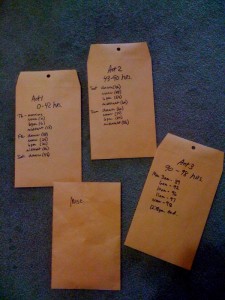
In Roz Morris’ Nail Your Novel book, (a great book to use when writing your first draft!) she suggests that you use a box and just throw in ideas. The ideas can come from brainstorming or from research about a topic. Don’t worry about where the bit of action goes in the story, just write it on a card and throw it into the mix.
When the box is full, or when you’ve done enough research, then you can sort through ideas and evaluate if they will fit into your novel. You’ll want to toss some of them as unsuitable for your story. The rest, though, you can start to sort and put into a reasonable order.
Because my novel has a tight time line, I’ve done a modification. As shown in the picture here, I’ve created three envelopes. As I’m doing research and brainstorming, I’m slotting events loosely into Act 1, Act 2 or Act 3 of my novel. So, use one big envelope or box or several envelopes based on whatever division works for your novel. For example, you might want to use one envelope for each subplot, or perhaps for each major setting of your novel.
In any event, I’m still trying out voices and still plotting. What stage is your WIP at?

I found this post by Debbie Wiles utterly fascinating.
And, in some strange way, encouraging.
I mean, this is DEBORAH WILES, people! (But I like to call her Debbie because I want her to be my best friend and come to my birthday party.)
Fascinating point #1: She can scrap an entire draft without hurling herself into the middle of the interstate.
Fascinating point #2: She has sense enough to write down that thought that popped into her head.
Fascinating point #3: She is courageous enough to start writing a book with no idea where it is going.
Fascinating point #4: She is willing to share this amazing process with others.
Fascinating point #5: She's going to do it by Labor Day. She IS going to do it by Labor Day.
The encouraging part?
She gives me hope that maybe I can write a draft by Labor Day.
I can, right?
So, I'm sharing what I have - which isn't very much. But it will grow.
 Those different colors, by the way, represent viewpoints. The yellow is OMNISCIENT. Eeeek! Those different colors, by the way, represent viewpoints. The yellow is OMNISCIENT. Eeeek!
At least, that's what I'm calling it. According to this, the first one is panoramic. ??
Whatever.
It's still kind of freaking me out and making me question every word I write on the paper.
But if Debbie can do it, I can do it.
Go, Debbie, go!
View Next 10 Posts
|


































 I like the idea of place holders in fiction. That is, you write something–a sentence, a title, a paragraph, a joke, a piece of dialogue–knowing that this isn’t the best it can be, but also knowing that you’ll come back and fix it.
I like the idea of place holders in fiction. That is, you write something–a sentence, a title, a paragraph, a joke, a piece of dialogue–knowing that this isn’t the best it can be, but also knowing that you’ll come back and fix it.



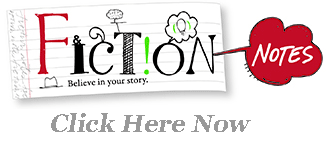




Great post and very good advice. I'm a fan of recycling too. Sometimes just a small tweak with a new audience in mind gives new life and a new meaningful twist to an article, story or post.
I love the story of your old professor. I am curious as to who that is. :) I think maybe if we all chewed on cigars, it would be easier for us to recycle our work? :) Thanks for the post.
Thanks, Julia. And, as you say, it's neat when the twist takes you to a new place.
Margo, definitely true about the cigars. We need mental cigars at least. Have you read David Lodge's Trading Places? Note the character of Morris Zap.
Great idea Judy! Of course the concept of recycling depends on having produced something to recycle...... :) Edith xxx
Yes, I do this and it sometimes felt like I was "cheating" so thanks for the permission.
Susie
Very good advise. I was just relating the recycle concept to my daughter who is faced with writing multiple essays for college aps and scholarships.
Ah, but Edith you do produce those lovely blog posts!
Recovering Church Lady, I love your title. I know the feeling, but if you add something, revise something, tighten something the piece becomes new or just better. My famous professor says "Go thou and recycle."
Lynne, I've been through that with my daughter too, and I've given her just the same advice.
I too loved the idea of shitty first drafts and have practiced that philosophy for years. When it comes to recycling, it's also appealing but I feel like the "younger you" in the story. Can I do that?? I'm curious if it's a deliberate process for you. Do you come up with recyclable ideas from the outset or is it more of a process done in hind sight? Once you have a piece you look for ways to recycle?
One of my English profs gave the same advice. He didn't have a cigar, though. ;)
I try to recycle every piece I write. It makes sense and makes me a better writer.